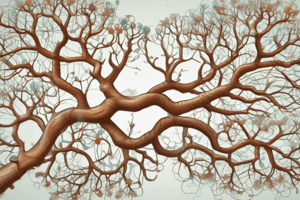Podcast
Questions and Answers
Which branch of biology focuses on the study of interactions between organisms and their environment?
Which branch of biology focuses on the study of interactions between organisms and their environment?
- Ecology (correct)
- Molecular Biology
- Genetics
- Microbiology
What is the primary function of mitochondria in a cell?
What is the primary function of mitochondria in a cell?
- Cell signaling
- Protein synthesis
- Waste management
- Energy production (correct)
Which of the following is NOT a mechanism of evolution?
Which of the following is NOT a mechanism of evolution?
- Gene flow
- Cell division (correct)
- Genetic drift
- Natural selection
What is the term for the study of the structure, function, and behavior of cells?
What is the term for the study of the structure, function, and behavior of cells?
Which of the following is an example of symbiosis?
Which of the following is an example of symbiosis?
What is the term for the process by which genetic information is passed from DNA to RNA?
What is the term for the process by which genetic information is passed from DNA to RNA?
Flashcards are hidden until you start studying
Study Notes
Biology
Branches of Biology
- Botany: study of plants
- Zoology: study of animals
- Microbiology: study of microorganisms
- Ecology: study of interactions between organisms and their environment
- Genetics: study of heredity and variation
- Molecular Biology: study of biological molecules
- Biochemistry: study of chemical processes in living organisms
Cell Biology
- Cell: basic unit of life
- Components:
- Plasma membrane
- Cytoplasm
- Nucleus
- Mitochondria
- Endoplasmic reticulum
- Ribosomes
- Components:
- Cell division:
- Mitosis: somatic cell division
- Meiosis: reproductive cell division
Genetics
- DNA (Deoxyribonucleic acid): genetic material
- Double helix structure
- Composed of nucleotides (A, C, G, T)
- Genes: functional units of heredity
- Expression: transcription and translation
- Inheritance patterns:
- Mendel's laws:
- Law of segregation
- Law of independent assortment
- Law of dominance
- Mendel's laws:
Evolution
- Theory of evolution: change in species over time
- Mechanisms:
- Mutation
- Gene flow
- Genetic drift
- Natural selection
- Mechanisms:
- Evidence for evolution:
- Fossil record
- Comparative anatomy
- Molecular biology
- Biogeography
Ecosystems
- Levels of organization:
- Individual
- Population
- Community
- Ecosystem
- Biosphere
- Energy flow:
- Producers (plants, algae)
- Consumers (herbivores, carnivores, omnivores)
- Decomposers (bacteria, fungi)
- Ecological relationships:
- Predator-prey
- Symbiosis (mutualism, commensalism, parasitism)
Biology
Branches of Biology
- Botany studies plants
- Zoology studies animals
- Microbiology studies microorganisms
- Ecology studies interactions between organisms and their environment
- Genetics studies heredity and variation
- Molecular Biology studies biological molecules
- Biochemistry studies chemical processes in living organisms
Cell Biology
- A cell is the basic unit of life
- Cell components include:
- Plasma membrane
- Cytoplasm
- Nucleus
- Mitochondria
- Endoplasmic reticulum
- Ribosomes
- Cell division occurs through:
- Mitosis (somatic cell division)
- Meiosis (reproductive cell division)
Genetics
- DNA is the genetic material
- DNA has a double helix structure
- DNA is composed of nucleotides (A, C, G, T)
- Genes are functional units of heredity
- Gene expression involves transcription and translation
- Inheritance patterns follow:
- Law of segregation
- Law of independent assortment
- Law of dominance
Evolution
- The theory of evolution states that species change over time
- Mechanisms of evolution include:
- Mutation
- Gene flow
- Genetic drift
- Natural selection
- Evidence for evolution comes from:
- Fossil record
- Comparative anatomy
- Molecular biology
- Biogeography
Ecosystems
- Levels of organization in ecosystems are:
- Individual
- Population
- Community
- Ecosystem
- Biosphere
- Energy flow in ecosystems occurs through:
- Producers (plants, algae)
- Consumers (herbivores, carnivores, omnivores)
- Decomposers (bacteria, fungi)
- Ecological relationships include:
- Predator-prey
- Symbiosis (mutualism, commensalism, parasitism)
Studying That Suits You
Use AI to generate personalized quizzes and flashcards to suit your learning preferences.




